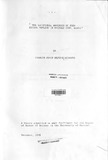| dc.description.abstract | Since its inception, the Nairobi population
growth rate has been high, between 6% and 8% per annum.
By the years 1985 and 2000, the City population is
expected to reach a mark of one and two million inhabitants
respectively.
Most of the foodstuffs in Kenya are handled,
marketed and some distributed by parastatal bodies
like Kenya Meat Commission, the Horticultural Cooperative
Union, Kenya Creameries Cooperative, and Maize
Produce and Marketing Board. Though these boards hold
exclusive responsibility of distributing food products
mainly in Urban areas, Nairobi consumers complain about
food shortages, poor quality food products, and high
prices.
There is scant information about food marketing
system in Nairobi. The little that there is,is based on
horticultural products at the only Wakulima Wholesale
!~arketwhich handles 58% of the fruit and vegetables
consumed each year. There is virtually no information
on the food retail sector. Unfortunately, the
neglected retail sector is part of the overall food
marketing chain which could hamper the economic development
of any c6untry if not properly developed.
This study endeavours to reveal the locational
food marketing system in the city. To fulfil this
objective, field studies were carried out between
April and June 1977 covering 21 City locations.
Personal interviews were conducted with a sample of
food retailers at three operational levels and consumers.
Secondary data on nine identified retail outlet
types depicting their distribution and densities
in various socio-economic locations and zones as of
1976/77 were compiled and their development into 1985
projected. The outline account of the outlet registration
procedures, marketing system and channels is given.
To determine the various retailers' procurement
activities and costs, their sources of food supply,
frequencies of food purchase, modes of transport and
transport costs are dealt with in depth. The same
parameters above are utilized to determine consumers'
procurement activities and costs. Retailers' margins
and consumers' monthly food expenditures are analysed.
In additio~ information on retailers' and consumers'
constraints, complaints and assistance required is
noted.
After the analysis of both primary and secondary
data, the general consensus reveals that the Nairobi food
retail marketing syste~ is inefficient. The system
lacks vertical and horizontal ~oordination which has
led to unnecessarily high procurement costs to both
retailers and consumers especially in low-income locations.
About 60% of the Nairobi population resides
in low-income areas and are served by numerous small
scale traditional outlets operating in poor sanitary
conditions. Their frequent low volume food purchases
have led to increased procurement costs,high food
prices, hindered improvement in food qualities and
expansion of retail premises. The ambulatory vendors
who significantly play a great role in conveying foodstuffs
to most Nairobi consumers are stumbling blocks
to any efforts to improve food qualities. Through
established modern public retail markets, the City
food retail outlet planners seem to have failed to
take in consideration the locational population growth
rates as demonstrated by the heavy infiltration of
ambulatory vendors in old estates. The established
modern retail markets have failed as sources of foodstuffs
to consumers due to poor structural plans of
the markets and lack of an effective method to control
the unscruplous ambulatory vendors. Generally consumers
find their residential outlets inconvinient, inadequate
regarding product ranges offered and food prices high.
The study concludes that the development of
improved retail markets and provision of external aid
to small scale operators (i.e. kiosk-retailers and
ambulatory vendors) in most low-income locations should
have top-priority. Establishment of wholesale/retail
outlet units in City outskirts should be encouraged
if the retail vertical and horizontal coordination is
to be boosted. | en |

